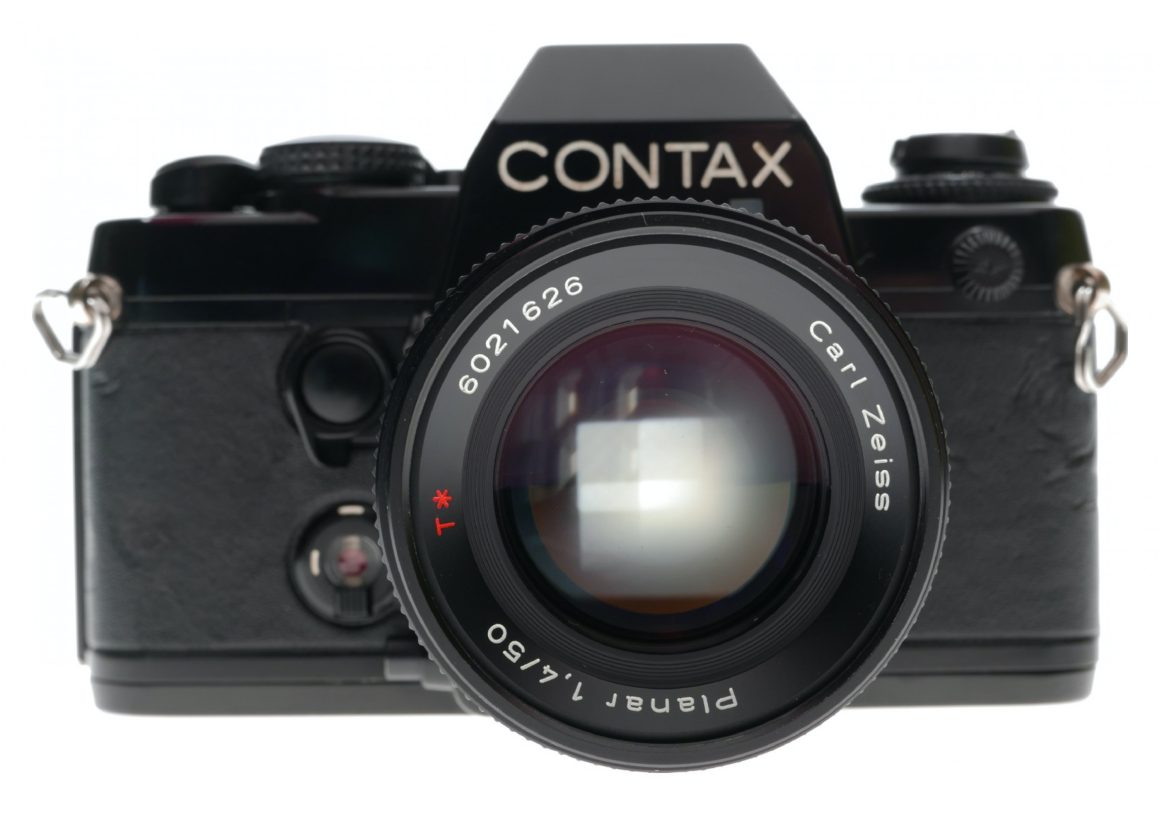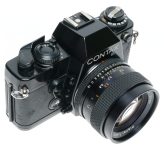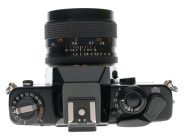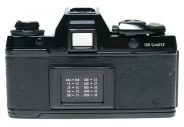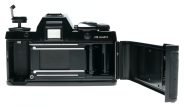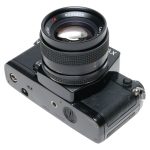Contax 139 Quartz
35mm MF film SLR camera
Specification
| Production details: | |
| Announced: | 1979 |
| System: | ● Contax/Yashica (1975) |
| Format: | |
| Maximum format: | 35mm full frame |
| Film type: | 135 cartridge-loaded film |
| Mount and Flange focal distance: | Contax/Yashica [45.5mm] |
| Shutter: | |
| Type: | Focal-plane |
| Model: | Electronically controlled |
| Speeds: | 11 - 1/1000 + B |
| Exposure: | |
| Exposure metering: | Through-the-lens (TTL), open-aperture |
| Exposure modes: | Aperture-priority Auto |
| Manual | |
| Physical characteristics: | |
| Weight: | 500g |
| Dimensions: | 135x85.5x50mm |
Manufacturer description #1
Type: 35 mm SLR featuring auto/manual exposure; direct TTL auto flash control.
Lens Mount: Large-diameter Contax/Yashica Mount accepting CARL ZEISS T* interchangeable lenses.
Standard Lens: CARL ZEISS PLANAR T* f/1.7 50 mm, CARL ZEISS PLANAR T* f/1.4 50 mm
Shutter: Quartz-timed, electronically operated vertical-travel metal focal-plane shutter. Speeds continuously variable on AUTO from 1/1000 to 11 sec. Manual shutter speeds from 1/1000 sec. to 1 sec. in clickstop setting, plus X (1/100 sec.) and "B". X-synch terminal on camera body.
Shutter release: Real Time Electromagnetic Release System featuring quartz-timed operating sequence; auxiliary remote release via "release socket" (electronic accessory connection) on camera body.
Self-timer: Quartz-timed electronic self-timer with 10-sec. delay; LED flashes during operation and accelerates 2 sec. before shutter release.
Exposure Control (non-flash system): Through-the-lens (TTL), full aperture light reading via SPD cell; center-weighted metering pattern. EV range from EV 0 to 18 at ASA 100 with f/1.4 lens.
Exposure Check: Exposure check pushbutton on front of camera lights LED array in viewfinder; shuts off automatically after 10 sec.
Exposure Compensation: +2 EV ~ -2 EV via exposure compensation dial (locks at X1 setting). Exposure memory via AE (auto exposure) lock lever which locks exposure reading at given reading; continuous-lock capacity.
Auto Flash Control: Via built-in direct TTL auto flash control system; couples with TLA Auto Flash unit to regulate flash output via SPD sensor. Average reading the film plane at all apertures; automatic 1/100 sec. flash synch with TLA Auto Flash unit (slowe synch possible via AE Lock); effective ASA range from 25 to 800.
Viewfinder: Silver-coated, fixed eye-level pentaprism type with horizontal split-image/microprism focusing screen; field shows 95% of the picture area; 0.86 X magnification (with 50 mm lens).
Viewfinder display: Auto/Manual LED dot shutter-speed display (a constantly-lit LED indicates the camera's continuously varied reading on AUTO; with manual operation a flickering LED indicates the manual setting, a constantly-lit LED gives the recommended exposure); aperture readout window, exposure compensation indication, LED flash data indicator (with after-flash signal to indicate subject was within flash range); LED over/underexposure warning, AE Lock warning.
Film advance: Single-frame advance with rapid advance lever, 135 deg. setting angle, 30 deg. rest. Film rewind via rewind release button and crank.
Multiple Exposure: Via multi-exposure button (disengages counter to keep accurate exposure count).
Other Features: Couplings for exclusive 139 Winder and TLA20 auto flash, interchangeable back accepts 139 Data Back; auto resetting additive-type exposure counter, depth-of-field preview button, tripod socket, memo holder.
Power source: Two 1.5V silver-oxide batteries (Eveready S76, Ucar S76, Mallory MS-76 or equivalent).
Battery check: Via exposure check button (LED sequences vary when batteries are low).
***
The 139 Quartz is the world's first high quality single-lens reflex camera with AE and manual modes incorporating a high precision quartz crystal for time control. Various fucntions such as continuous AE lock function, TTL automatic metering system of the flash by 2 mode exposure measurement, electronic self-timer, and the viewfinder information system are incorporated within the compact body.
Manufacturer description #2
For the first time in the history of photography, total control and absolute precision are available in a system of photographic equipment capable of meeting every challenge. The CONTAX 139 Quartz brings to photography the fantastic accuracy of quartz crystal timing - combined with the system advantages of Real Time operation.
This combination of quartz timing and Real Time operation now gives photographers the capability to capture precisely on film the image created in the viewfinder - without time-lag, exposure error or any of the variables that so often limit conventional photographic systems.
The CONTAX 139 Quartz is an integral part of the world-famous Contax Real Time System, the system that has revolutionized photography in recent years. It is a compact, lightweight, 35mm SLR camera available with a 50mm f/1.7 standard lens of the Zeiss T* line, or an optional high-speed 50mm f/1.4. Or, the 139 Quartz body can be purchased separately to fit into an existing Real Time System equipment line.
On its own or as part of an overall system, however, the CONTAX 139 Quartz offers unbelievable control over any photographic situation. Exposure factors are computed automatically in the camera body by the most advanced combination of electronics and data-processing hardware ever employed in camera design. And the 139 Quartz also offers full manual control over exposure settings.
To take full advantage of the amazing exposure accuracy of the system, quartz crystal control regulates each timing step in the photographic process. And the entire sequence progresses at the Speed Of Light! because it is fully electronic. This is the meaning of Real Time Photography - even the slightest time delay is completely eliminated. Among the major feature advantages of the CONTAX 139 Quartz are the following:
Quartz Crystal Control - A unique property of quartz crystal is its ability to generate pulses at an absolutely uniform rate of 32,768 Hz per second. This superb precision, an integral part of precision timing devices worldwide, has now become the key to ultimate accuracy and control in photography. Shutter speeds, for example, can be set to a degree of accuracy never before approached.
Two-Mode SPD Exposure Control - The 139 Quartz employs two SPD (Silicon Photo Diode) cells to control exposure factors. One SPD measures light through the lens for ordinary exposures, while the other takes reflected readings from the film surface to control electronic flash exposures.
Real Time Electromagnetic Release System - Identical to the system used in the famed CONTAX RTS, this release system is the heart of Real Time Photography. At a stroke of just 0.7mm, the release initiates shutter operation which is fully electronic, to eliminate delay and allow Real Time operation.
Automatic TTL Flash Exposure Control - Through Real Time operation with the TLA-20 Auto Flash unit, the 139 Quartz controls flash output precisely, through-the-Iens, for absolute accuracy with every flash exposure.
Zeiss T* Lenses - The 139 Quartz shares the outstanding system of Carl Zeiss T* lenses developed specially for the CONTAX system of Real Time Photography. This is, without doubt, the finest system of lenses every produced for a 35mm single-lens-reflex camera.
CONTAX Real Time System Accessories - The 139 Quartz matches with its own special auto winder, electronic flash and data back, but shares with the CONTAX RTS and 137 MD Quartz the capability to employ almost the entire range of system accessories available in the Real Time System of photography.
Micro-Computerized Control of the Photographic Process
Quartz crystal timing is the heart of the CONTAX 139 Quartz, and Real Time operation is its legs.
But the 'brain' of the 139 Quartz is the combination of an advanced Central Processing Unit micro-computer with data processing circuitry capable of achieving unparalleled accuracy in exposure calculation.
The Central Processing Unit is based on a digital C-MOS LSI chip. Expose input data goes directly to a special Bi-MOS analog integrated circuit. This circuit processes the data from analog to digital form, and relays it to the C-MOS chip. Then, the CPU processes the data, and uses it to signal all related camera functions with the precise factors needed to achieve a perfect exposure of the scene in the viewfinder.
Aperture, film speed and exposure compensation [if any] data feeds to the analog system, which integrates these factors with the raw exposure data before CPU operation determines the final, precise shutter speed to be employed. And in addition to this ultimate control over exposure values, the CPU also coordinates the operation of all accessory equipment used with the 139 Quartz, such as the Auto Winder, TLA-20 Auto Flash, Data Back, etc. And full information on exposure data is relayed to the viewfinder's 'Pulsar' LED display system.
Electromagnetic Operation of the Photographic Process
"System" - in photographic terminology - means far more than simply the availability of a few lenses and accessories; it indicates a fully integrated equipment system capable of taking maximum advantage of every photo opportunity and meeting the challenge of widely varying photo situations.
And it also implys a central control over each function and step in photography. The CONTAX Real Time System, as applied to the 139 Quartz, revolves around a unique Electromagnetic Shutter Release which controls and coordinates every step of the photographic process, instantaneously, to achieve Real Time operation.
Mechanical linkage, with its inherent time lag in operation, has been replaced with a release system that utilizes the Real Time capabilities of electromagnetics. With a stroke of just 0.7mm, the release initiates and controls the entire photographic sequence.
And this same electromagnetic system meshes fully with the operation of all Real Time System accessories, to provide, for the fi rst ti me, a true photographic 'system' capable of meeting every challenge.
As an integral part of the electromagnetic release system, the 139 Quartz includes a dial for setting the proper ASA film speed factor for films rated from 12 to 3200. The protective collar around the release rotates to allow exposure compensation (for strong backlighting or creative control over exposures without switching to full manual) in incremental steps.
The 139 Quartz features a full range of manual shutter speeds, from one to 1/1000th sec., along with bulb and X-synch settings. In the 'AUTO' position, the dial transfers full control of exposures back to the micro-computerized data processing center. One special feature of the 139 Quartz is the automatic setting of the proper X-synch shutter speed, by the Central Processing Unit, when the TLA-20 Auto Flash unit is employed.
Full Information Viewfinder Display
A special 'Pulsar' LED display in the 139 Quartz viewfinder gives full exposure data information in the AUTO mode, an indication when the AE Lock system is operating, full information on proper manual exposure settings and indication of electronic flash operation. This LED display is activated for 10 seconds at a single touch of the exposure check button. In addition, a window at the top of the viewfinder indicates the aperture setting in use. Incorporated into the exposure check button is a special AE Lock control, which freezes exposure data to allow compensation for backlighting or other varying conditions. The AE Lock can also be set for continuous operation, when the 139 Winder is attached to the camera for sequential photography.
The rugged, secure, three-claw bayonet lens mount of the 139 Quartz is the same used for both the CONTAX and Yashica FR series, allowing the full range of Carl Zeiss T* lenses or Yashica ML lenses to be used, along with all lens-mounting accessory equipment. This mount allows full automatic diaphragm operation and keeps the lens in perfect alignment at all times, while providing fast, simple, convenient changing of lenses.
The Quartz Self-Timer can be set by means of a simple lever on the front of the camera body, and activated by pressing the shutter button. The system provides a precise, 10-second delay, and operation is indicated by a flashing red LED. The LED flash accelerates during the final two seconds before the shutter releases, to warn that the actual photo process is about to begin.
Table of contents
Clickable
Contax/Yashica system cameras
Clickable
- Contax 137 MA Quartz
- Contax 137 MD Quartz
- Contax 139 Quartz
- Contax 159 MM
- Contax 167 MT
- Contax Aria
- Contax AX
- Contax RTS
- Contax RTS II Quartz
- Contax RTS III
- Contax RX
- Contax RX II
- Contax S2
- Contax S2b
- Contax ST
- Yashica 107 Multi Program
- Yashica 108 Multi Program
- Yashica 109 Multi Program
- Yashica FR
- Yashica FR I
- Yashica FR II
- Yashica FX-1
- Yashica FX-103 Program
- Yashica FX-2
- Yashica FX-3
- Yashica FX-3 Super
- Yashica FX-3 Super 2000
- Yashica FX-70 Quartz
- Yashica FX-D Quartz
